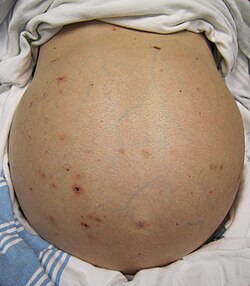| Liver failure | |
|---|---|
| Other names | Hepatic insufficiency, liver dysfunction |
 | |
| A person with massive ascites and caput medusae due to cirrhotic liver failure | |
| Specialty | Gastroenterology, hepatology |
| Symptoms | abdominal inflammation, fluid retention, hyperglycemia, nausea, vomiting, jaundice, acute or chronic fatigue, hyponatremia, hypokalemia, respiratory alkalosis, metabolic acidosis, bilirubinuria, glycosuria, pruritus |
| Risk factors | Excessive consumption of alcohol, fatty foods; obesity; Type 2 Diabetes; sharing or reusing syringes |
Liver failure is the inability of the liver to perform its normal synthetic and metabolic functions as part of normal physiology. Two forms are recognised, acute and chronic (cirrhosis). [1] Recently, a third form of liver failure known as acute-on-chronic liver failure (ACLF) is increasingly being recognized. [2]